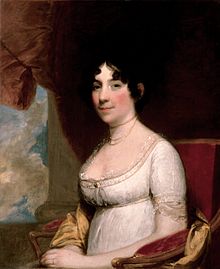Early Life
Dolley Madison was born on May 20, 1768 to Quakers John Payne and Mary Coles in Guilford College, North Carolina. She had three brothers and three sisters. When she was an infant, her family moved to her grandparents’ plantation in Virginia. There Dolley attended Quaker school and learned how to read, write, and do arithmetic. At the end of the American Revolution, at the age of fifteen, her family moved once again, this time to Philadelphia. Dolley’s father attempted to start a laundry starch business but it failed. As a result, her family was disowned by the Quakers because their immense debt. First Marriage
In January 1790, at age twenty one, Dolley married lawyer and fellow Quaker John Todd. They had two sons, John Payne and William Temple. However, in the fall of 1793, a yellow fever epidemic spread through Philadelphia, killing Dolley’s husband and youngest son. Second Marriage
Afterwards, at a party, Aaron Burr, the senator of New York introduced Dolley to James Madison, who was seventeen years older. He was also quite the opposite of her as he was shy, short, and easy to overlook. But they began courting each other and eventually fell in love. Dolley and James Madison wed on September 15, 1794. However, since James was Episcopalian, Dolley was cut off by the Quakers for not marrying a man of the same faith. Dolley spent the early years of her marriage learning about the social world of Washington D.C. She attended parties filled with political dignitaries and observed their behaviors. In 1801, her husband became President Thomas Jefferson’s secretary of state. Jefferson’s wife had recently died and his daughters sometimes could not make it to Washington D.C. to entertain guests so Dolley substituted as his hostess. First Lady
Since she was no longer a Quaker, she began wearing the latest fashions in bright colors and bold patterns. She quickly learned the skills of hostess in Washington D.C. Dolley knew how to make feel comfortable while keeping the room circulating to meet her husband. By hosting regular social gatherings, she made the White House beautiful, cheerful, and lively. This atmosphere was significant as it lightened the strict mood and provided harmony to calm tension in heated arguments. Dolley eventually helped her husband defeat Charles Pinckney for the presidency in 1809. As the First Lady, she held lavish dinner parties and Wednesday evening receptions where politicians, diplomats, and citizens alike attended. Her outgoing extroverted attitude perfectly complemented her husband’s quiet reserved manner. With her knowledge of politics and current events, Dolley also affected Madison’s decisions as president. Saving the Painting of Washington
During the War of 1812, Dolley decreased her parties but still had receptions to celebrate American victories. But this changed in August 1814, when the British landed in Maryland and began marching toward Washington D.C. Madison insisted that Dolley escape but she refused and instead, ordered a carriage to the front door of the White House. She loaded most of her husband’s work papers as well as books, china, silver, and paintings. One of the most famous paintings Dolley saved was Gilbert Stuart’s rendition of George Washington. After finally fleeing the city, the British looted and burned Washington D.C. Coming from the front lines, President Madison returned to Washington D.C. on August 27. He found Dolley already waiting for him as she entered as soon as she heard word that the British left. Later Life
Since the White House was burned to the ground, Dolley and her husband lived in the Octagon House, the second largest house in Washington D.C. In the next year, they moved to a group of connected buildings called the Seven Buildings. After Madison’s last term ended in 1817, the two returned to their Virginia home, Montpelier. Soon, Madison’s health began to deteriorate. Dolley hardly left his side even when he died in 1836 at the age of 85. Nevertheless, Dolley returned to Washington D.C. in June 1837. During the latter part of her life, she worried about finances because her son had amassed a huge gambling dept. She even had to sell her treasured Montpelier to pay off his bills. In addition, Congress had to buy Madison’s papers and put Dolley on a trust fund that gave her a very small income. At the age of eighty one years old, she died on June 12, 1849. Her funeral took place five days later and was attended by President Zachary Taylor and his whole cabinet, along with her friends from over seventy five years under the public eye. She was buried in the Congressional Cemetery but was later moved beside her husband in Montpelier. |
|
"I am accordingly ready; I have pressed as many Cabinet papers into trunks as to fill one carriage; our private property must be sacrificed, as it is impossible to procure wagons for its transportation" |
